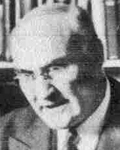|
|
|
|
|||||||||||||||||
| * * * * * HERMENEUTICS: The Science of Interpreting the Scriptures
To understand hermeneutical principles is to be equipped for an intelligent study of the Word of God, tending greatly to our approval before God as workmen that do not need to be ashamed. "Some Basic Rules of Interpretation" by Dr. David L. Cooper, founder of the Biblical Research Society, contains key principles that are essential to a healthy hermeneutic.
|
|||||||||||||||||||
|
|
SOME BASIC
RULES |
|
|||||||||||||||||
|
|
|||||||||||||||||||
|
|
|||||||||||||||||||
|
* *
*
We are to stop there and are not to read subjectively into the record
something that is foreign to the context. The Word of God is spiritual and
does not need our "doctoring" it in order to make it more so. If one man
can read into a given context his own ideas and claim that such is the
significance of the passage, another can do the same thing and can read
into the record his conception of its meaning. Whenever we adopt the
spiritualizing method, we open the floodgates to every type of
speculation, suggestion, and theorizing. We must not therefore go beyond
the plain, literal meaning of the Scriptures unless the facts of the
context indicate a deeper, hidden, or symbolic meaning. When therefore
such evidence is lacking, one must positively accept the literal meaning
of the text. On the other hand, if there is absolute proof that the
language is, for instance, symbolic, then we are to interpret the given
passage in the light of all the evidence, not only of the immediate
connection, but in the light of that which is found in parallel cases - if
there be such.
This rule assumes that all truth harmonizes and that there are no discrepancies between accurate statements of facts. But for those who wish the maxim stated in its unabridged form, I give it in the following words:
If anyone follows this criterion, in the spirit and letter of the principle, he can never go wrong. On the other hand, if he fails to follow it, he can never be right. (May I suggest that the reader memorize and master this rule in order that he may be governed thereby in all his study of the Word?) This principle is true, not only as it applies to the Bible, but also to any written document or oral conversation regarding any subject.
"The law of first mention" is another most important principle involved in the Scriptures. What is meant by it is that
As an illustration of this law, I need only to call attention to the sacrifices that were required by the Lord from Cain and Abel. The very fundamental teaching concerning atonement for sin, with all its implications, is found in these sacrifices, as recorded in Genesis 4. Once more, the promise and the covenant which God made with Abraham (Gen. 12:1-3) constitute the bold outline of all that is involved in the divine plan which runs through the Scriptures. It becomes therefore of paramount importance that one study words, doctrines, and institutions in their original, initial mention.
As we have just seen in our study of the Golden Rule of Interpretation, we must seek diligently, by the application of this standard, to ascertain the exact thought of the speaker or writer whose message is studied. When this is learned, we can determine whether or not there is involved in the discussion some fundamental principle. If there is such set forth in the given case, we are at liberty to apply it to a similar situation; but, before we do, we must be certain that there is an analogy justifying such an application. It is at this crucial point that many mistakes are made. All too often efforts are made to see a spiritual lesson in a given scripture and, without due consideration, to apply it to another case which only apparently is analogous.
for one of the basic tenets of true science is that "like causes under like conditions produce like results." My caution to everyone is that he be certain to discover the exact thought of the writer and that he be absolutely sure in making an application of the principle discovered to a similar situation. Such a procedure is legitimate and proper.
There is what is known among Bible students as "the law of double reference or manifold fulfillment of prophecy." We find many applications of this principle.
This principle might be illustrated by a stereopticon which gives the
dissolving effect. One picture is thrown upon the screen. Presently it
begins to fade and at the same time the dim outline of another begins to
appear. By the time the first has faded, the second is in full view. The
prophets often blended a prediction relating to the first coming of Christ
with one foretelling the second advent. In such presentations the entire
Christian Dispensation is passed over.
A principle which obtains throughout the prophetic word is that which is known by Bible students as "the law of recurrence." According to the meaning of this phrase,
The second presentation is but supplemental to the first. It therefore
clarifies the picture. COMPARING SCRIPTURE WITH SCRIPTURE
God gave His Word as He wanted us to have it, and as He wanted us to
study and teach it. An investigation of the Scriptures shows that He only
gave any portion of it as there was a demand for the enunciation of some
new principle or the reiteration and the augmentation of one that He had
already revealed. A study of the life of our Lord shows that He often
repeated Himself. We are told that circumstances alter cases. After all,
people's experiences are more or less of a certain definite type. These
and other facts show why it was necessary for God to repeat certain
doctrines in sending messages to various people or groups of individuals.
The biblical writers, meeting a local and a similar situation, were forced
to repeat many things.
He must, as far as it is possible, get all the facts which called forth the explanation. Moreover he must study it in the light of the facts of its context. When he has thus examined the various passages bearing upon a given question and has gleaned from each reference what is said, he can put all the information together and thus have a complete picture. It is therefore necessary for everyone to compare scripture with scripture. In following this principle he must be absolutely certain that he views each passage in its proper perspective. When he does so, he will see that one account usually supplements another.
Then we should study the entire connection and be certain that we get
the drift of thought of the original writer. Speaking figuratively, we
must see the quotation in the original setting. When we have done this, we
are to study the context of the New Testament in which this quotation is
found. Frequently the application will throw light upon the passage in its
original connection and vice versa.
Thought-rhyme was the fundamental idea of Hebrew poetry. No effort was made at meter, verse, and rhyme as we have in modern poetry. What is Hebrew parallelism? The answer is this:
The second, therefore, is supplemental to the first and becomes a
comment upon it. Sometimes one of the statements is in literal language,
whereas the other is more pictorial and, graphic; but each supplements the
other.
All peoples, both ancient and modern, have symbols. The Hebrews had
theirs. Those appearing in the Scriptures however are of divine origin. In
fact, the Tabernacle and the Temple, with all of their ceremonial
services, were typical or symbolic of the realities which we have in
Christ. That they had such a significance is set forth clearly in the New
Testament. The Book of Hebrews especially interprets the spiritual
significance of the ritualism of the Old Testament.
To illustrate the point let us look at an example or two. Joseph, we
are often told, is a type of Christ. Isaac's taking Rebekah as his bride
is also a type of Christ's taking His bride, the church. What inspired
writer gives any intimation to this effect? I have never seen anything in
the Scriptures to warrant these positions. I admit that there are striking
similarities in the cases; but analogies are not equivalent to a "thus
saith the Lord." We do well, therefore, to have scriptural authority for
whatever we say. One can, by allowing his imagination to run wild, see
that a certain person or thing in the Old Testament is typical of
something in the New. Another person, looking at the same thing, will see
a different signification. Thus there are untold possibilities of
speculation and error, which are dangerous whenever there is not a "thus
saith the Lord" for a given position. FIGURATIVE LANGUAGE The languages of all peoples seem to have begun largely with figures of speech--at least primitive writing indicates this position. It is by comparison that we appreciate and understand things. Thus figures have remained in our language and adorn it greatly. In fact, it is most difficult for us to speak without using some figures of speech. The Bible is no exception.
The fact that a figurative expression occurs in a given passage is no
warrant for one's taking its meaning and forcing it upon another passage
unless the facts of the given context show that the same figure was used
in a like manner. To be more specific, let me call attention to the
expression found in Ephesians regarding Christ's "having cleansed it
[church] by the washing of water with the word" (Eph. 5:26). This
statement is figurative language. We must not force this metaphorical
sense upon another passage, which might in some way resemble this one
passage, unless the facts of the latter context permit such an
interpretation.
As an illustration of this principle, I may call attention to Psalm 45:
6. "Thy throne, 0 God, is for ever and ever ..." In the original text of
this statement there are only four words. Nevertheless, they can be
rendered grammatically to make four or five translations. By supplying
different words, the number of renderings can be multiplied. This thing
has been done by certain ones who have been unwilling to accept the plain
meaning. But our one concern is, What did the psalmist have in mind when
he by the Spirit of God used these words? One must study the entire psalm
in order to see the proper connection; then he must compare all the facts
discovered with statements found in other places which are capable of only
one interpretation.
In the English language there are eight parts of speech. These, taken
together, constitute language. Each of them has a definite, specific use
and relation to other parts of speech. It becomes absolutely necessary, if
one is to arrive at the exact meaning of a word, that he know grammar,
since each part of speech has a definite purpose and since words likewise
have accurate definitions. One therefore must, if he is to arrive at the
exact idea which the Holy Spirit had in mind, have an adequate knowledge
of grammar and the meaning of words.
With such definite information in hand, one can, by the aid of the Holy Spirit, understand, as a rule, the message. I therefore accept the correctness of this method of exegesis.
The student should have a good English dictionary at hand when he
studies the Scriptures--unless he has an adequate idea of the vocabulary
that is used in the Bible. If a person will only look in an unabridged
dictionary of the English language, he will see that some words have many
meanings or shades of ideas. This statement being true, one must know
these various definitions in order to comprehend rightly the exact meaning
of a given passage.
Our English dictionaries give the current meaning of words as they are employed now by the best speakers and writers. They also give colloquial usages. The Bible employs a certain definite usage that was current when the Scriptures were given.
For instance, a prophet was simply a spokesman from God who delivered a message to the people. Sometimes he discussed things past; on other occasions, matters regarding things present in his day; and often those things lying in the future. At the present time, the word, "prophetic," as we have already noticed, is largely used with reference to future things. There are many changes that have taken place in our language. This fact demands that we compare scripture with scripture in order to see the usage to which a term was applied then. We must not therefore read back into the Scriptures definitions of words as they are being used today; because, as stated, practices have been introduced and changes have been made which have definitely determined present-day usage.
The Revised Version puts the original meaning of the Word of God in our current vernacular. It is a most excellent translation and presents the message of the original text more nearly accurately than former official versions. For this reason I always insist on everyone's using the Revised Version. |
|||||||||||||||||||
|
* * * * * Reprinted by permission of the
Biblical
Research Society, where other
|
|||||||||||||||||||



